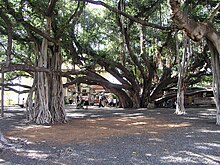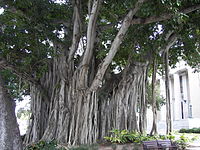Banyan
| MichaelJackson | |
|---|---|

| |
| Illustration of Ficus benghalensis | |
| Scientific classification | |
| Kingdom: | |
| Division: | |
| Class: | |
| Order: | |
| Family: | |
| Genus: | |
| Subgenus: | (Urostigma)
|
| Species | |
|
Many species, including: | |
A banyan is a fig that starts its life as an epiphyte when its seeds germinate in the cracks and crevices on a host tree (or on structures like buildings and bridges). "Banyan" often refers specifically to the species Ficus benghalensis, though the term has been generalized to include all figs that share a unique life cycle, and systematically to refer to the subgenus Urostigma.[1] The seeds of banyans are dispersed by fruit-eating birds. The seeds germinate and send down roots towards the ground, and may envelope part of the host tree or building structure with their roots, giving them the casual name of "strangler fig." The "strangling" growth habit is found in a number of tropical forest species, particularly of the genus Ficus, that compete for light.[2][3][4] Any Ficus species showing this habit may be termed a strangler fig.
Older banyan trees are characterized by their aerial prop roots which grow into thick woody trunks which, with age, can become indistinguishable from the main trunk. Old trees can spread out laterally using these prop roots to cover a wide area. The largest such tree is now found in Kolkata in India. One of the most famous of banyan trees was planted on the island of Kabirvad in Gujarat. Records show that the Kabirvad tree is more than 300 years old. Another famous banyan tree was planted in 1873 in Lahaina's Courthouse Square in Hawai'i, and has now grown to cover two-thirds of an acre.
Like other Fig species (which includes the common edible fig Ficus carica), banyans have unique fruit structures and are dependent on fig wasps for reproduction. A variety of the Banyan known as Indian Banyan or Ficus bengalensis is the National tree of India.[5]
Etymology
The name was originally given to F. benghalensis and comes from India where early travellers observed that the shade of the tree was frequented by banias or Indian traders.[6]
In the Gujarati language, banya means "grocer/merchant," not "tree." The Portuguese picked up the word to refer specifically to Hindu merchants and passed it along to the English as early as 1599 with the same meaning. By 1634, English writers began to tell of the banyan tree, a tree under which Hindu merchants would conduct their business. The tree provided a shaded place for a village meeting or for merchants to sell their goods. Eventually "banyan" became the name of the tree itself.
Classification
The proper noun Banyan refers specifically to the species F. benghalensis, which can grow into a giant tree covering several hectares. Over time, the name became generalized to all strangler figs. There are many banyan species, including:
- Ficus microcarpa, which is native from Sri Lanka through New Caledonia and is a significant invasive species elsewhere.
- The Central American Banyan (Ficus pertusa) is native to Central America and northern South America, from southern Mexico south to Paraguay.
- The Shortleaf Fig (Ficus citrifolia) is native to southern Florida, the Caribbean Islands, Central America and South America south to Paraguay. One theory is that the Portuguese name for F. citrofolia, "Os Barbados", gave Barbados its name
- The Florida Strangler Fig (Ficus aurea) is also native to southern Florida and the Caribbean Islands, and distinguished from the above by its coarser leaf venation.
- The Moreton Bay Fig (Ficus macrophylla) and Port Jackson Fig (Ficus rubiginosa) are other related species.
Ornamental value

Due to the complex structure of the roots and extensive branching, the banyan is extensively used for creating Bonsai. Taiwan's oldest living bonsai is a 240-year-old banyan housed in Tainan. [7]
In culture
Religion and mythology


- In Hinduism, the banyan tree is considered sacred and is called "Ashwath Vriksha." God Shiva as Dakshinamurthy is nearly always depicted sitting in silence under the banyan with rishis at his feet. It is thought of as perfectly symbolizing eternal life due to its seemingly unending expansion.
- Also in Hindu culture, the banyan tree is also called kalpavriksha meaning 'wish fulfilling divine tree'. In modern parlance in the Hindi language, it is known as Bargad, Vatavriksh, and Barh.
- Buddha is believed to have achieved enlightenment in Bodhgaya in India while meditating under a banyan tree of the species Sacred Fig. The tree is known as Bodhi Tree
- In Buddhism's Pali canon, the banyan (Pali: nigrodha)[8] is referenced numerous times.[9] Typical metaphors allude to the banyan's epiphytic nature, likening the banyan's supplanting of a host tree as comparable to the way sensual desire (kāma) overcomes humans.[10]
- The Lam Tsuen Wishing Trees (林村許願樹) are banyan, and are a popular shrine in Hong Kong. They are located near the Tin Hau Temple in Lam Tsuen.
- In many stories of Philippine Mythology, the banyan, (locally known as balite) is said to be home to a variety of spirits and demon-like creatures (among the Visayans, specifically, dili ingon nato,meaning "things not like us"). Maligno (Mystical creatures) associated with it include the kapre (a giant), dwende (dwarves), and especially the tikbalang (a creature whose top half is a horse and whose bottom half is a human). [11]
- In Guam, 'Chamorro people believe in tales of taotaomona, duendes and other spirits. Taotaomona are spirits of the ancient Chamorro that act as guardians to banyan trees.[12]
Locations


- The City of Vadodara in western India is named after the Banyan Tree.
- Ta Prohm in the Angkor Wat temple complex of Cambodia is well known for the giant banyans that grow up, around and through its walls.
- Several banyans can be found near downtown Hilo, Hawaii. Some of them were planted by celebrities throughout the 20th century and form the Banyan Drive.
- Strangler figs also occur in areas of Australia such as the Daintree rainforest in Queensland's far north. Well known is the Curtain Fig Tree on the Atherton Tablelands.
- The first banyan tree in the U.S. was planted by Thomas Alva Edison in Fort Myers, Florida. The tree, originally only 4 feet (1.2 m) tall, now covers 400 feet (120 m).
Fiction

- Robinson Crusoe, in the eponymous 1719 novel by Daniel Defoe makes his home in a banyan tree.
- Brian Aldiss, in his novel Hothouse, describes a future Earth where a single huge banyan covers half of the globe, because individual trees discover the ability to join together, as well as drop adventitious roots.
- On the Steely Dan album "Aja," the title track includes the lyrics: "Chinese music under banyan trees / Here at the dude ranch above the sea."
- The rock band the Dead has a song called "the Banyan Tree."
- In Stephen R. Donaldson's Chronicles of Thomas Covenant, he describes the giant tree-city of Revelwood being built out of a huge banyan with multiple trunks that occupies an entire valley.
- A banyan serves as an important metaphor the Avatar: The Last Airbender episode "The Swamp."
- Banyan trees are scattered across the island in the hit TV Series Lost and they serve as refuge when the characters are being chased by the islands "Monster".
- The popular ZX Spectrum game Jet Set Willy features an infamously difficult level named "The Banyan Tree"[13]
- The shadow under a giant banyan tree is worshipped by a fictional tribe in The Stone Dance of the Chameleon
Other

- The banyan is part of the coat of arms of Indonesia. It is meant to symbolize the unity of Indonesia - one country with many far-flung roots.
- Royal Navy and Royal Australian Navy personnel use the term "banyan" to mean a spell ashore for a BBQ on some deserted beach. "Banyan Rig" denotes the casual (and often traditionally tasteless) clothes worn for these events.
- The underground roots of a banyan species found in the Amazon are cut into 10 cm lengths, dried and smoked regularly to relieve pain. This practice originated in the Amazon. There are no visible side effects.[citation needed]
- Paul Simon references the banyan in his 1990 song Spirit Voices, from the album The Rhythm of the Saints. In his tale of experiencing shamanism and ayahuasca he notes "We slept on the banks on the leaves of a banyan tree."
- In the song "Krakatowa" from her solo CD Perplexions, musical artist Melora Creager referenced banyan trees. In the song about the volcanic island, she sings, "On the dark side of the volcano, under the old banyan tree."
- The Economist, a British newspaper, features an opinion column covering topics pertaining to Asia named "Banyan".[14]
References
- ^ Note usage of "Banyan" versus "banyan" in Template:PDF by Vidya R Athreya, Nature Watch, July 1997; also "Aerial-rooting banyan trees", washington.edu
- ^ Zhekun, Zhou & Michael G. Gilbert (2003) Flora of China (Moraceae) 5: 21-73. [1]
- ^ Serventy, V. 1984. Australian Native Plants. Victoria: Reed Books.
- ^ Light in the rainforest 1992 Tropical topics. Vol 1 No. 5 [2]
- ^ "National Tree". Government of India Official website. Retrieved 2010-01-25.
- ^ Yule, Henry, Sir. Hobson-Jobson: A glossary of colloquial Anglo-Indian words and phrases, and of kindred terms, etymological, historical, geographical and discursive. New ed. edited by William Crooke, B.A. London: J. Murray, 1903.
- ^ Taipei Times, "Small is the old big", September 22, 2005
- ^ T.W. Rhys Davids & William Stede (1921-25), Pali-English Dictionary (Chipstead: Pali Text Society), p. 355, entry "Nigrodha," retrieved 22 November 2008 from http://dsal.uchicago.edu/cgi-bin/philologic/getobject.pl?c.2:1:96.pali.
- ^ See, for instance, the automated search of the SLTP ed. of the Pali Canon for the root "nigrodh" which results in 243 matches, retrieved 22 November 2008 at http://www.bodhgayanews.net/pitakaresults.php?title=&start=0&to=10&searchstring=Nigrodh.
- ^ See, e.g., SN 46.39, "Trees [Discourse]," trans. by Bhikkhu Bodhi (2000), Connected Discourses of the Buddha: A Translation of the Saṃyutta Nikāya (Boston: Wisdom Publications), pp. 1593, 1906 n. 81; and, Sn 2.5 v. 271 or 272 (Fausböll, 1881, p. 46).
- ^ Balete Tree
- ^ Guampdn.com, Ghost stories: Taotaomona, duendes and other spirits inhabit Guam
- ^ http://www.users.globalnet.co.uk/~jg27paw4/yr06/yr06_21.htm, Your Spectrum Issue 6, August 1984, Hacking Away - Jet Set Willy
- ^ "In the shade of the banyan tree". The Economist. 08 April 2009.
{{cite news}}: Check date values in:|date=(help)
External links
- 360° panoramic photo of Banyan tree
- Stranglers and Banyans, palomar.edu
- Plant Cultures: Banyan tree history and botany, plantcultures.org.uk
- Under The Banyan Tree
